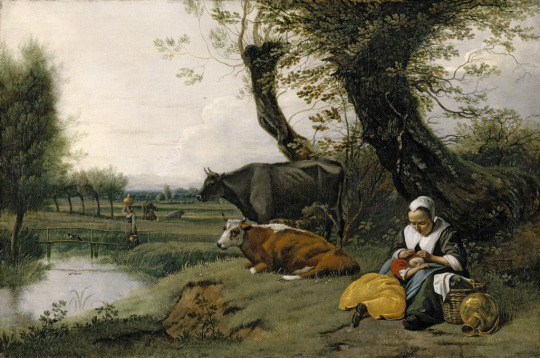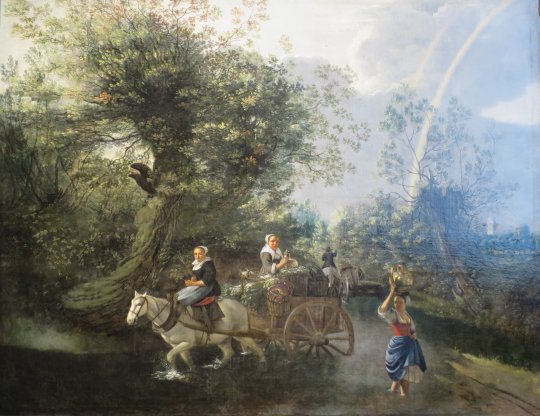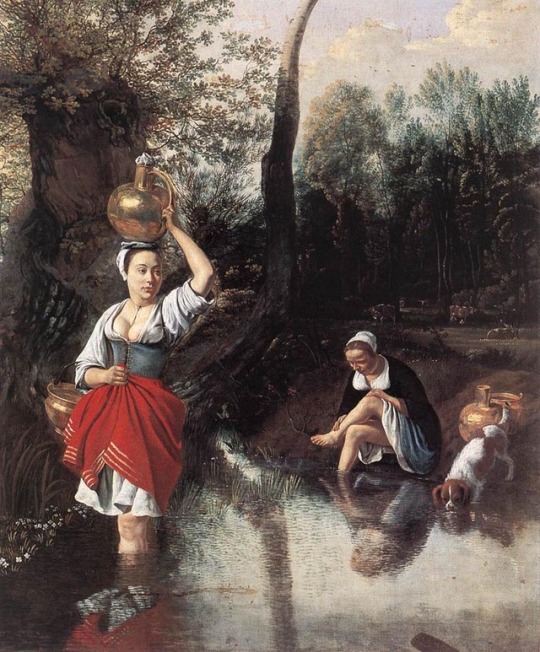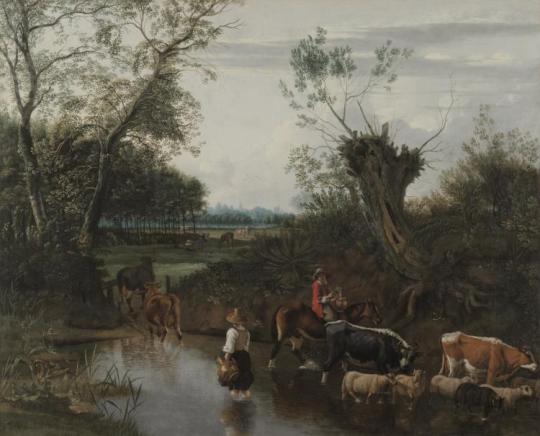#jan siberechts
Text

Jan Siberechts (Flemish, 1627-1703)
Wollaton Hall and Park, Nottinghamshire, Detail, 1697
Yale Center for British Art
#Jan Siberechts#flemish art#flemish#belgium#belgian#art#fine art#european art#classical art#europe#european#oil painting#fine arts#europa#wollaton hall#wollaton hall and park#nottinghamshire#1600s#landscape art#landscape painting#landscape#grand house#architectural art#architectural#architecture#architecture art
41 notes
·
View notes
Text

Jan Siberechts
A Ford (detail)
1665
#art#baroque art#17th century#reflections#genre painting#art detail#kmska#art i saw today#jan siberechts
10 notes
·
View notes
Text

Wollaton Hall and Park, Nottinghamshire: Jan Siberechts.
86 notes
·
View notes
Text

Titulo completo: Un vaquero pasando un caballo y un carro en un arroyo
Artista: Jan Siberechts
Fechas de artistas: 1627 - 1700/3
Fecha de realización: probablemente 1658
Medio y soporte: Óleo sobre lienzo
Dimensiones: 63,8 × 54,3 cm
Resumen de inscripción: Firmado; Con fecha de
crédito de adquisición: Presentado por John P. Heseltine, 1907
Aquí, el arduo viaje de un carro cargado desde la granja hasta el mercado es el sueño de la vida en el campo de un habitante de la ciudad. Jan Siberechts vivía en la ciudad de Amberes y se ganaba la vida produciendo este tipo de escenas para una clientela urbana. Basándose en su experiencia en el campo alrededor de la ciudad, idealizó lo que había visto, retratando al 'campesino' como una figura noble y trabajadora, que mostraba pocas señales de los efectos del trabajo en un país donde las condiciones podían ser duras.
Siberechts ha pintado un idilio, pero son los detalles y las texturas lo que parece haberle dado más placer: los pliegues del cuello de la anciana cosquilleados por las hojas plumosas debajo; la luz del sol sobre las robustas piernas de la muchacha y los pliegues de su enagua blanca; el brillo en el duro cuerno de la vaca junto a su esponjoso mechón de pelo. Todos estos son parte de la ilusión idílica, pero eran, para las personas que vivían en las ciudades cambiantes de Flandes del siglo XVII, nostálgicos y tranquilizadores.
Información e imagen de la web de la National Gallery de Londres.
2 notes
·
View notes
Text

Jan Siberechts
‘Nottingham from the East’ c.1695
6 notes
·
View notes
Text
~Paintings~

A view of Chatsworth from the east. {primary image}
Acquired in 2017, this detailed view painting is on display at Chatsworth now. This painting from the 1st Duke of Devonshire’s period is shown alongside a series of landscape paintings detailing major changes to the house and garden through more than 300 years. At the time of its creation, the Duke of Devonshire said, “I am extremely excited that this landscape has joined the Devonshire Collection. It will be of great interest to our visitors as it portrays on a grand scale a complete view of Chatsworth House, Garden and Park as built and laid out by the 1st Duke and this enables us all to know so much more about Chatsworth at the very beginning of the 18th century.”
It is known though that this large view of Chatsworth originally belonged to Admiral Edward Russell, later 1st Earl of Orford, a friend and political colleague of the 1st and 2nd dukes of Devonshire. Russell and the future 1st Duke had both been signatories to the secret document inviting Prince William of Orange to take the English throne. As Russell had no children, the painting passed on his death to his great-niece Letitia Tipping who married the 1st Lord Sandys in 1725. It remained in the Sandys family until 2017.
The painting was transformed when fully cleaned before its sale. It enabled art historians to attribute the painting to Jan Siberechts, a Flemish-born artist who specialised in painting bird’s eye views of English country houses in the late seventeenth century.
youtube
Harvard referencing:
A View of Chatsworth from the East (no date) Chatsworth House. Available at: https://www.chatsworth.org/visit-chatsworth/chatsworth-estate/art-archives/devonshire-collections/paintings/view-of-chatsworth/ (Accessed: 19 September 2023).
1 note
·
View note
Text

Jan Siberechts, Pastoral Scene, circa 1667-1668, oil on canvas
#some art i saw with ratatouille#look how cute the cows are!!!!!#my favorite is the red one sitting down and i think that it's a hereford (?)#i also like the woman knitting under the tree#jk she is not knitting#she is comforting a child#ncma#i want to go to there
0 notes
Text

Family Portrait, Said to be of the Van der Witte Family, Depicted on a Rise Overlooking Their Estate, Gillis van Tilborgh and Jan Siberechts, between 1654 and 1675
#art#art history#Gillis van Tilborgh#Jan Siberechts#portrait#portrait painting#group portrait#family portrait#landscape#landscape painting#Baroque#Baroque art#Flemish Baroque#Flemish art#17th century art
51 notes
·
View notes
Photo

Crossing a Creek
Jan Siberecht
1669
4 notes
·
View notes
Photo

2.
Jan Siberechts
Wollaton Hall and Park, Nottinghamshire
17th century, oil on canvas
88 notes
·
View notes
Photo

Nicolas de Largillière - Portrait of Jan Siberechts - 1674-79
Nicolas de Largillière (10 October 1656 – 20 March 1746) was a painter born in Paris, France. Largillière's father, a merchant, took him to Antwerp at the age of three. As a boy, he spent nearly two years in London. Sometime after his return to Antwerp, a failed attempt at business led him to the studio of Anton Goubau. However, Largillière left at the age of eighteen and went to England, where he was befriended and employed by Peter Lely for four years at Windsor, Berkshire.
Jan Siberechts (1627–1703) was a Flemish landscape painter who after a successful career in Antwerp, emigrated in the latter part of his life to England. In his early works, he developed a personal style of landscape painting, with an emphasis on the Flemish countryside and country life. His later landscapes painted in England retained their Flemish character by representing a universal theme. Siberechts also painted hunting scenes for his English patrons. The topographical views he created in England stand at the beginning of the English landscape tradition.
Jan Siberechts was born in Antwerp, the son of a sculptor with the same name. He trained in Antwerp with his father and became a master in the local Guild of Saint Luke by 1648. It is possible but not certain that in the late 1640s, early 1650s he visited Italy. He married Maria-Anna Croes in Antwerp in 1652. He developed a personal style of painting landscapes, which impressed George Villiers, 2nd Duke of Buckingham when he visited Antwerp in 1670. The Duke invited the artist to England.
Siberechts arrived in England around 1672 and spent the first three years in England painting decorations in the Duke’s newly built Cliveden House at Taplow, Buckinghamshire, England. From the second part of the 1670s and in the 1680s he travelled widely in England completing numerous commissions for aristocratic clients. He lived in London where one of his daughters was a lace-maker for the Queen. His younger daughter, Frances, married the Flemish émigré sculptor Artus Quellinus III (known in England as 'Arnold Quellinus') and, after being widowed, John Nost, another Flemish émigré sculptor. Whilst in London he was commissioned to paint the Belsize Estate of goldsmith banker John Coggs in 1696, which now hangs in the Tate Gallery London.
He died in London.
John Wootton was one of his pupils.[9]
10 notes
·
View notes
Photo

The Wager, 1665
Jan Siberechts, 1627-1703
78 notes
·
View notes
Photo

View of a House and its Estate in Belsize, Middlesex, 1696 by Jan Siberechts (Flemish, 1627--c.1700/3)
157 notes
·
View notes
Photo

Peasants Crossing a Stream, Jan Siberechts , c. 1670, Cleveland Museum of Art: European Painting and Sculpture
Size: Framed: 119 x 143 x 9 cm (46 7/8 x 56 5/16 x 3 9/16 in.); Unframed: 99.7 x 122.5 cm (39 1/4 x 48 1/4 in.)
Medium: oil on canvas
https://clevelandart.org/art/1969.18
7 notes
·
View notes

